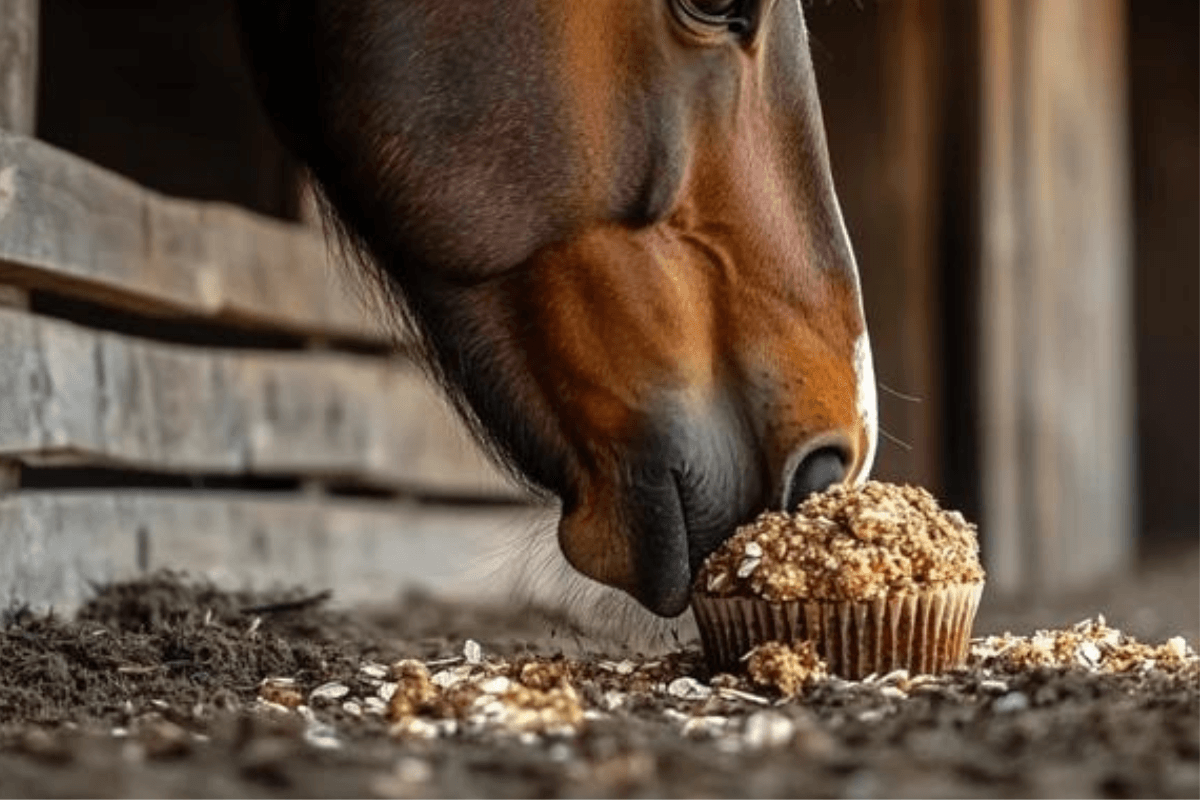Stud muffins are a tasty treat for horses, but like any snack, moderation is key to ensuring your horse remains healthy and happy. In this article, we’ll explore how many stud muffins are safe for a horse to have, what factors you should consider when feeding treats, and how to balance treats with a nutritious diet.
Treats are an essential part of horse care. Not only do they provide a way to reward good behavior, but they also offer an opportunity for horse owners to bond with their animals. That said, understanding the nutritional value and safe consumption limits of treats like stud muffins is vital to your horse’s long-term health.
What Are Stud Muffins for Horses?
Stud muffins are a popular horse treat made with natural ingredients like oats, molasses, bran, and apples. They offer a delicious reward for horses during training or as a snack. While these treats provide a burst of energy and nutrition, it’s important to understand that they should complement your horse’s regular diet, not replace it.
Stud muffins stand out from other treats because of their homemade nature. You control the ingredients, ensuring they are free from artificial additives and unnecessary sugars. The combination of oats and molasses in stud muffins is a perfect match for horses, as oats provide a slow release of energy, and molasses enhances the flavor with natural sweetness.
The Purpose of Treats in a Horse’s Diet
Treats like stud muffins serve several purposes in a horse’s diet. They can be used as rewards during training, for bonding, or as a way to add variety to your horse’s routine. Offering treats like muffins can help reinforce positive behaviors, making them an excellent tool in training. For instance, when teaching a horse to follow commands, a stud muffin can be the perfect way to encourage compliance.
However, treats should never exceed more than 10% of a horse’s daily caloric intake, as an excess of treats can disrupt their balanced diet and lead to health problems such as weight gain or digestive issues. It’s easy to get carried away with giving treats, especially when your horse responds positively, but keeping portions in check is essential.
How Many Stud Muffins Can a Horse Have Per Day?
The number of stud muffins a horse can have depends on several factors, including the horse’s size, age, and activity level. Generally, 1 to 2 stud muffins per day is a safe amount for most horses. However, there are other considerations that can influence how many muffins your horse should consume.
1. Horse Size and Weight
Larger horses, such as draft horses, may be able to handle an extra muffin or two without any issues. On the other hand, smaller breeds or ponies should stick to the lower end of the treat limit. For instance, a draft horse weighing 1,800 pounds can likely consume 2 or more muffins a day without any problems, while a smaller horse or pony weighing 700 pounds should only have 1 muffin.
Horse size plays a significant role in determining the appropriate amount of food, including treats. For a large horse in regular work, a treat like a stud muffin is unlikely to make much of a difference in terms of caloric intake. But for a smaller horse or pony, even one or two treats can add extra calories, leading to weight gain if not monitored carefully.
2. Horse Activity Level
An active horse that is regularly exercised may be able to handle a slightly higher number of treats. Stud muffins contain oats and molasses, which provide quick energy. Horses that are involved in high-intensity activities such as racing, jumping, or eventing may benefit from the extra energy boost. However, a sedentary horse or one that is prone to weight gain should only be given a small amount to avoid unnecessary calorie intake.
For example, a performance horse that regularly competes in events may require a higher caloric intake to maintain energy levels. In such cases, the additional calories from a stud muffin can be a positive contribution to their diet, helping replenish energy after rigorous activities. On the other hand, a retired or lightly worked horse might not need this extra energy, and excessive treats could lead to problems like obesity.
3. Health Conditions and Age
Horses with certain health conditions, such as insulin resistance, laminitis, or obesity, should avoid treats high in sugar, like stud muffins. If your horse has a metabolic disorder, consult your veterinarian before introducing any new treats. Similarly, older horses may have different dietary needs, and treats like stud muffins should be given cautiously.
As horses age, their metabolism can slow down, and they may develop conditions that affect how they process sugar. For older horses with dental issues, harder treats can also pose a challenge. Stud muffins, which are soft and easy to chew, can be a better alternative to crunchy treats. However, it’s still important to limit sugary snacks and opt for lower-sugar versions of stud muffins if necessary.
4. How Treats Fit Into the Horse’s Diet
Incorporating treats like stud muffins into a horse’s diet should be done with balance and thoughtfulness. Horses require a well-rounded diet primarily consisting of forage, such as hay and grass, and a controlled amount of grains or concentrates to meet their energy needs. Treats should complement, not replace, these essential components of the diet.
According to Nutrition.gov, horses, like humans, benefit from diets low in added sugars. While molasses in stud muffins adds flavor, it also contributes to the sugar content. Limiting sugary treats ensures that your horse remains at a healthy weight and reduces the risk of metabolic diseases.
The Role of Stud Muffins in a Balanced Diet
Stud muffins, while tasty and packed with ingredients like oats and molasses, should only make up a small portion of your horse’s overall diet. Horses require a diet rich in forage, such as hay and grass, as well as a balanced amount of grains and supplements. Treats like stud muffins should be used sparingly and only as a complement to their main diet.
Why Moderation Is Important
Horses have sensitive digestive systems, and feeding them too many sugary treats can lead to digestive upset, weight gain, or even colic. Over time, excess sugar can also lead to insulin resistance, which may increase the risk of metabolic issues. To prevent these problems, always keep treats, including stud muffins, to a minimum.
It’s easy to think that giving a few extra treats won’t hurt, but excess sugar can contribute to long-term issues. Metabolic conditions, such as Equine Metabolic Syndrome (EMS) or insulin resistance, can be aggravated by the regular consumption of sugary snacks. Maintaining moderation in treats not only keeps your horse’s weight in check but also protects their long-term health.
How to Incorporate Stud Muffins Into Your Horse’s Routine
While it’s clear that moderation is key, stud muffins can still be an enjoyable and useful addition to your horse’s routine when used appropriately. Here are some tips on how to introduce stud muffins safely into your horse’s diet.
1. Use Them as a Reward
Stud muffins are perfect for rewarding your horse after a training session or for good behavior. Because they are rich in flavor, horses often respond positively to them during training, making them a great tool for reinforcing desired behaviors. However, it’s important to be consistent with treat distribution so that your horse doesn’t become dependent on treats for every task.
Using stud muffins as rewards helps strengthen the bond between horse and owner. For example, after completing a jump or successfully responding to a command, a small stud muffin can positively reinforce the horse’s behavior. It’s crucial, however, to ensure the treats are given sparingly so that the horse continues to view them as a special reward rather than an expected part of daily interactions.
2. Balance with Regular Feed
While treats like stud muffins are a great way to bond with your horse, they should not interfere with their regular feeding routine. Make sure your horse is consuming enough forage and grains to meet their nutritional needs. Keep treats to a small percentage of their daily intake to avoid any disruptions to their diet.
The horse’s main diet should always consist of at least 80-90% forage. Any grain or concentrate should be provided based on the horse’s activity level, age, and health status. Treats, like stud muffins, should never replace meals but can be added sparingly for variety and pleasure.
3. Monitor Weight and Behavior
When introducing stud muffins into your horse’s diet, keep a close eye on their weight and overall behavior. Some horses may show signs of gaining weight quickly, while others may exhibit behavioral changes due to an increase in sugar intake. Monitor these factors and adjust treat distribution as needed.
In addition to weight gain, behavioral changes such as restlessness or excitability can indicate that your horse is consuming too much sugar. If this happens, reduce or eliminate sugary treats like stud muffins and consult your veterinarian for advice on balancing your horse’s diet.
Nutritional Breakdown of Stud Muffins
Stud muffins are typically made with ingredients like oats, bran, molasses, and apples, which provide a source of energy and essential nutrients. Here’s a brief breakdown of the main components:
- Oats: Rich in carbohydrates and fiber, providing energy and supporting digestive health.
- Bran: High in fiber, which aids in digestion and helps prevent digestive issues like colic.
- Molasses: A natural sweetener that horses love, but it contains sugar, so it should be fed in moderation.
- Apples: Provide vitamins and natural sweetness, adding flavor and nutritional value to the muffins.
Even though these ingredients are nutritious, they are still calorie-dense, so feeding too many stud muffins can lead to weight gain or an imbalance in your horse’s diet.
Common Mistakes to Avoid When Making Stud Muffins
While making stud muffins is simple, there are a few common mistakes that can affect the quality of your treats:
1. Using Too Much Molasses
While molasses adds sweetness, using too much can lead to excessive sugar intake. Stick to the recommended amounts to keep the muffins healthy. Remember that while molasses makes the muffins appealing, moderation is essential to avoid overloading your horse with unnecessary sugar.
2. Not Adjusting for Consistency
The batter should be thick but not too dry. If your mixture is too dry, the muffins will crumble. Add water or applesauce as needed to achieve the right texture. A proper consistency ensures that the muffins bake evenly and are easy for your horse to chew.
3. Not Cooling Muffins Completely
Horses can burn their mouths if the muffins are served too hot. Make sure to let the muffins cool fully before offering them to your horse. Allowing them to cool also helps the muffins firm up, giving them the right texture for chewing.
Conclusion: How Many Stud Muffins Are Safe for Your Horse?
In conclusion, stud muffins can be a healthy and enjoyable treat for horses when given in moderation. Most horses can safely enjoy 1-2 muffins per day, depending on their size, activity level, and health status. Remember, treats should never make up more than 10% of your horse’s daily diet, and it’s important to monitor your horse for any signs of weight gain or digestive upset.
By following these guidelines, you can ensure that your horse enjoys stud muffins as part of a balanced, nutritious diet.
For more tips on feeding your horse, check out our guide on healthy horse nutrition to keep your equine companion in top shape.

